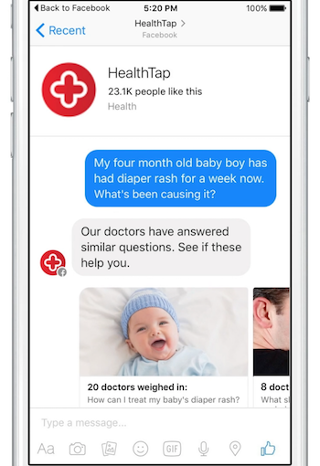Here's What you Need to Know About Bots
Bots are a hot topic in the tech and business world right now. If you spend any time on social media – and we know you do – you have likely come across a story or thirty about the takeover of bots. If you don’t know much about the bot movement or have tried to ignore it, the prospect can be a little intimidating. But it’s not all scary news. In fact, some bots are extremely helpful.
Below is an insightful post originally published on HubSpot’s ReadThink page on Medium by HubSpot Research and Mimi An. Dive in to learn all about how bots are making things easier.
What Are Bots?
Bots are defined as software designed to automate things that you do. But that definition on its own is not very helpful — what does that actually relate to in real life? The type of bots getting the most coverage use conversational UI and interface with an existing messaging application. They help the user of the app find information or get something done in a seamless, automated way through text-based commands (think typing out: “Hey, Pizza Hut bot! Send me a large pepperoni pizza” and the pizza shows up at your door 30 minutes later).
In North America, the best known example of a messaging app is Facebook Messenger. Whatsapp, also owned by Facebook, features bot integrations, too. And the list doesn’t stop there. In fact,there are a number of messaging apps and platforms — Slack, Twitter, etc. — investing in a bot platform and ecosystem. But for the sake of simplicity, our examples will focus on Facebook Messenger.
Time to connect the two concepts: Let’s say a third party company, like Lyft, creates a bot that interfaces with Facebook Messenger. When a Messenger user needs a ride, she can summon the Lyft bot and order a car to pick her up directly through her Messenger app. In other words, she doesn’t need to switch to the dedicated Lyft app to use Lyft’s service.
Facebook hopes to entice more companies to build bots on its messenger platform. And why would companies want to do such a thing? Facebook’s incredible reach and user base. With a bot integration, any company can provide services to over 900 million active Facebook Messenger users.
And by creating its own bot platform, Facebook instantly made its Messenger app stickier — who wouldn’t want to order a pizza, book a flight, talk to a customer service rep, and chat with their best friend all on the same application? Thus, the industry freakout.
What About Apps?
The bot play is coming at a time when the app platform appears to be in decline. There are still plenty of apps, but according to analysis from Comscore, app fatigue has set in. There are 1.5 million total apps available now in the Apple Appstore, but in this increasingly crowded landscape, most smartphone users can’t be bothered to add new apps to their roster. App downloads have slowed to a trickle in recent years — today, a smartphone user downloads zero new apps a month.
Comscore also calculated that 80% of a person’s mobile time is spent in just three apps. And the space is increasingly dominated by big players — as of April 2016, nine out of the top 10 used apps were made by Google and Facebook.

App leaders like Facebook, who want to guarantee that people spend most of their time in their apps, are placing big bets on aggregating content and collecting bot integrations to keep users active and engaged.

If Facebook and other platform’s platforms’ bet on bots works out, the use cases will not only have a significant impact on users’ lives, but they’ll also open up a new channel for businesses to reach a large audience. Early players are already exploring the following use cases:
Ecommerce
1–800 Flowers and Spring have made it easy for customers to shop for their products via Facebook Messenger. Both companies created simple conversation bots that directs buyers to the right locations or products, depending on the nature of their request:
Ecommerce Bots from 1–800 Flowers and Spring


Customer Service
Brands can also extend customer service into the Messenger app. In this use case, the buyer experience is very seamless, as all the details of their transaction appear in the same conversation thread.
Examples of customer service interactions

Bot enabled customer service can extend to other verticals beyond Ecommerce, too. In fact, even those dreaded interactions you have with your cable or internet provider can be simplified by bots, according to University of Toronto professor Joshua Gans. In an article for the Harvard Business Review, Gans recounted an interaction he has with a customer service bot from Rogers — a broadband Internet service provider in Canada, owned by Rogers Communications.
Gans noted that because of Messenger’s historical record keeping, he didn’t have to restate his problem when a new service representative took over his issue. There was also no need to re-enter account numbers when a different service agent picked up his conversation. On top of the ease of the interaction, Gans found that the conversation felt personable and friendly, which can make a big impact on the overall customer experience.
Customer service interaction from Rogers


Content Distribution
Messenger users will be able to summon content on demand via the Messenger app. This will be yet another channel content creators can utilize to connect with their readers. But the platform is ad free so content distributors will have to consider how to monetize their bot integrations, if at all.
Content on demand from CNN’s bot

Specialized Search and Services
Rather than go to a search engine or a topic-specific app, Messenger users can interface with bots to get answers to their questions. Topics can range from the weather outside to diagnosing illnesses and everything in between.
Poncho’s Weather bot

Medical advice from the HealthTap bot

Promotional Content
Marketing teams have already started using the channel to create buzz and promote upcoming releases. Adam Rosenberg, a writer for Mashable, shared his conversation with a bot created to promote the video game Call of Duty. The game’s publisher posted a YouTube video that linked to the messenger bot and teased the potential to uncover a special game code if people interact with the bot.
An interactive campaign promoting the video game Call of Duty

Enterprise/Business Enablement
This is a non-Messenger example, but it points to how businesses follow consumer behavior trends. Slack is a business messaging and communication platform that has taken off significantly in the past few years. And they feature an extensive bot store. A number of start ups have begun working on creating enterprise class business, marketing, and sales enablement bots to help professionals get their job done, including Troops, which recently raised $2.6 million dollars to connect Salesforce to Slack.
Troops’ bot aims to connect Salesforce to Slack

As Facebook rolls out its Facebook at Work service, we expect similar business focused apps to appear on its platform. According to Facebook press releases, bots from Salesforce and Zendesk are in process.
Proof Points: What is the Playbook?
Facebook, Slack, and other messaging services based predominantly in the West are not breaking new ground when it comes to pushing bot adoption. In fact, they’re mostly replicating a playbook pioneered by China-based technology company Tencent, who created a messaging app WeChat specifically with bot enabled integrations in mind. The strategy led to WeChat becoming one of the most dominant platforms in the region. WeChat has been staggeringly successful in Asia, but has limited penetration in Europe and the Americas. A select few organizations, with Facebook at the forefront, are now placing big bets on bots and racing to capture the North American and European market first.
The scope and breadth WeChat’s bot integrations are impressive. WeChat’s extensive bot ecosystem provide an example of what we may expect to see in the future if more service providers and business start integrating their services into bot platforms. Famed Venture Capital firm Andreeson Horowitz has an incredibly informative guide to WeChat’s success and penetration inChina, providing some interesting use cases that we may see in the future.
WeChat’s banking and money transfer integration

Scheduling a doctor’s appointment in WeChat

Using WeChat to monitor childcare and schooling

Final Takeaway
Andreeson Horowitz observed that bot-enabled apps like WeChat took off because Asia-based internet users prefer having apps that include multiple functionalities. In contrast, apps in the West developed as very specific, siloed tools that do only one thing. The big question is will western consumers adapt and embrace apps chock full of capabilities, or will they reject them in favor of point solutions? Obviously, companies like Facebook, Microsoft, and Twitter, among others, are betting big on bots, but there are some counterpoint opinions. Needless to say, it is still early — many have noted that bot technologies have not been sophisticated and the rollout has been rocky. But now you’re primed on bots, and you can watch (and make business plans) with us as the technology develops and adoption progresses.
Are computers replacing humans?
In short: not yet.
That’s what Ryan Block, co-founder of Begin, believes, anyway — and he knows a thing or two about bots. In fact, his team is building one of their own, one that helps you stay on top of everything you’ve got going on.
Ryan knows better than most what the bot timeline means for humans, and despite huge tech advancements, he’s largely skeptical.
In fact, he claims we’re “15 Nobel Prizes away” from anything that could even remotely replace humans.
Follow Readthink – from HubSpot – on Medium for more stories like this.








